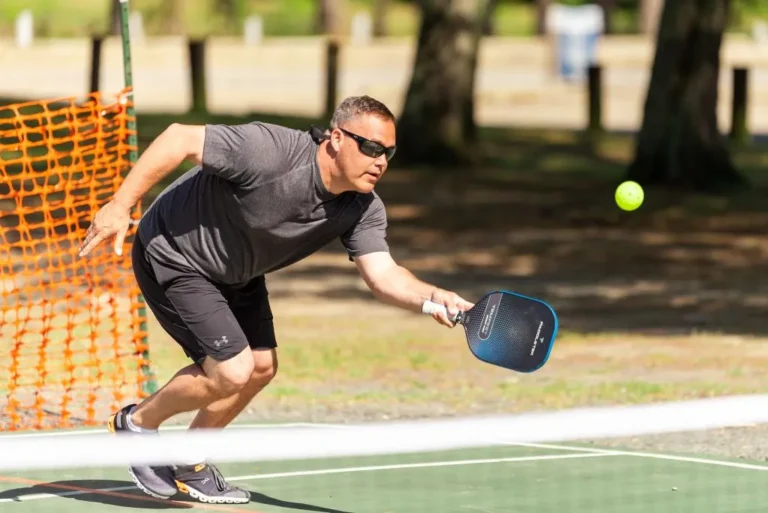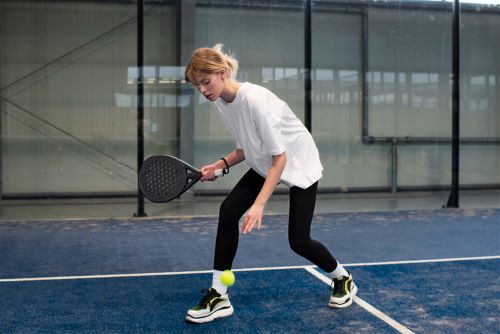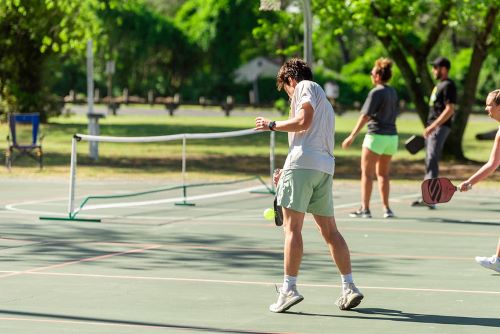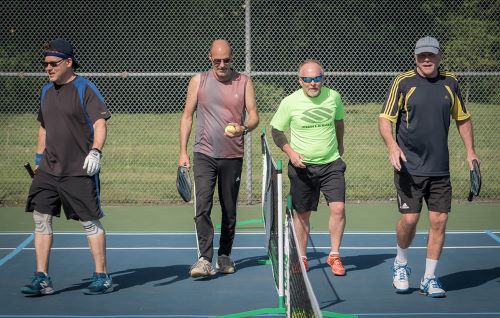
Pickleball’s rapid rise in popularity in America has been a remarkable trend in recent years. This sport—a hybrid of tennis, badminton, and table tennis—offers a unique playing experience that has attracted countless people.
However, the competitiveness that you see on television can be misleading. It might cause people to believe that pickleball is a tough, intense game. While the game can be intense sometimes, the reality is that this perspective only scratches the surface of what pickleball is truly about.
At its core, pickleball is a simple, inclusive, and fun game designed to be enjoyed by people of all ages and skill levels. Is it hard to play? Yes and no. Here’s why.
Is Pickleball Hard to Play?
Like many sports, the difficulty level of pickleball largely hinges on the skill level of the players and how competitive they are. For beginners and casual players, the game is easy to pick up and enjoy. But those wishing to play at a higher level will need to master all the techniques and strategies of pickleball, and this can be challenging.

Casual Pickleball vs Competitive Pickleball
There’s a huge difference between professional and casual pickleball and how they’re played. While the former is more competitive and skill-intensive, the latter is simple and inclusive, the way the makers of the game wanted it to be.
Initially, pickleball gained much of its popularity among elderly and physically unfit individuals who were looking for a low-impact sport. For them, the game was an avenue for fun, social interaction, and light exercise. The simplicity of the game allowed them to compete without the physical demands of more strenuous sports.
However, the increasing popularity of competitive pickleball has reshaped the public’s perception of the game. More professional players are taking up the sport, and their advanced skills and strategies make the game seem more complex than it was originally intended to be. The intense, fast-paced games on the tournament courts are a far cry from the friendly, leisurely games that are often played in local communities.
Pickleball: A Fusion of Three Sports
Pickleball borrows the simplest and most accessible aspects of tennis, table tennis (or ping-pong), and badminton. You’ll find familiar elements of these three popular racquet sports in pickleball’s gameplay, including the back-and-forth volleying, the use of a net, and the scoring system. These three sports combined created a unique game that is easy and fun to play.
For example, similar to tennis and ping pong, pickleball employs a serve-and-volley style of play. This familiarity can be a comfort to players transitioning from these sports. Many pickleball enthusiasts have past experiences with tennis or badminton, enabling them to adapt to pickleball quickly.
If you didn’t know, pickleball was invented by Joel Pritchard, Bill Bell, and Barney McCallum in the mid-1960s. The trio wanted to create a sport that their families could play together, irrespective of the players’ ages or skill levels.
They designed the game to be easy to understand, enjoyable, and less physically demanding than traditional racquet sports. At its core, pickleball was never designed to be a high-competition sport.
What Makes Pickleball Easier than Tennis, Ping Pong, or Badminton?
Pickleball has several features that make it physically easier to play compared to other racquet sports.

The Game is Physically Easier to Play
-
Court Size
The pickleball court is roughly a third of the size of a tennis court, measuring 20 feet by 44 feet. This smaller size means players cover less ground during a game, reducing the amount of running and movement required.
-
Balls
Even the balls used in pickleball, similar to whiffle balls, are lighter and travel at slower speeds of around 25 mph on a moderate hit. This makes the balls easier to hit and control, reducing the speed and strength needed to play effectively.
-
Paddles
The paddles, with dimensions of about 8 inches by 15.75 inches, are larger than table tennis paddles, but smaller and lighter than tennis racquets. This balance ensures that players can easily maneuver the paddle while maintaining a good hit surface area.
-
Low-impact Sport
One of the unique aspects of pickleball is it doesn’t rely heavily on physical strength. Players don’t need to hit hard or fast to return the ball effectively. This makes pickleball accessible to a wider range of people, including those who are physically unfit or elderly. The low-impact nature of the game places less stress on the joints, reducing the risk of injuries.
Beginner-Friendly Rules and Basics
Pickleball has a simple and straightforward set of rules that are easy enough to understand. While the game does have some intricate rules, they usually come into play at more advanced levels. So beginners can start playing after learning just the fundamentals of serving, scoring, and the various faults.
The official pickleball rulebook even includes guidelines to make the game accessible to players with disabilities, so even people with physical limitations can enjoy the fun and camaraderie that pickleball offers.
Pickleball Emphasizes Skill Over Physical Capability
For other sports like soccer or basketball, you have a significant advantage if you’re stronger and faster than your opponent. But in pickleball, the emphasis is more on your strategy and skills in shot selection, precision, and spin control. Your ability to hit accurate, smart shots holds more weight than the power behind them.
What Makes Pickleball Hard or Difficult Compared to Other Sports?
While pickleball shares similarities with other sports, and it was intended to be a fun, casual sport for families to enjoy, it does have its own unique rules that can confuse beginners.
The Kitchen or No-volley Zone
One confusing rule involves the ‘kitchen’, which is an area near the net where volleys are not allowed. Volleys are shots made without letting the ball bounce once. Because the kitchen is right next to the net, having players smash the ball from this area is a huge disadvantage to the opposing team. That’s why the kitchen is a no-volley zone.
Two-bounce Rule
There’s also the ‘two-bounce rule‘, which mandates that the service ball must bounce once on each side before volleys are allowed. This rule aims to prolong rallies and reduce the advantage of a serve, but it can confuse beginners who are not used to waiting for the second bounce.
Sideout Scoring and Reading Points
Pickleball uses the side-out scoring system, which is quite different from the rally scoring system used in other popular racquet sports. Sideout scoring can be tricky for new players. Here’s why:
- Only the serving team can score points.
- The receiving team won’t get a point if they win the rally. Instead, they get to serve the next rally.
- As the serving team, they can now earn points every time they win a rally.
- If they lose a rally, they go back to being the receiving team. And the other team becomes the serving team once more.
Understanding how to read points in a side-out scoring system can also be puzzling. For example, a score announcement of ‘2-3-1’ refers to the serving team’s score (2), the receiving team’s score (3), and the serving player’s position in the rotation (1).
Service Rules Can be Confusing, Especially for Doubles Players
The service rules in singles pickleball are fairly straightforward.
- The server must serve the ball diagonally across the court.
- The server must always start serving from the right-hand service square and can only score points when they are serving.
- After a fault, the serve switches to the other player.
However, doubles rules are much more intimidating. One rule that can confuse new doubles players is the sequence of service. After the first server loses its serve, the second server on the same team serves. When they lose their serve, the serve switches to the opposing team, and the player on the right serves. The team that is serving switches sides every time a point is scored.
This serving sequence and the addition of the two-bounce rule make it challenging to grasp for beginners, especially those who are used to the typical rally scoring system, which awards a team or player a point every time they win a rally, regardless of who served that round.
Is Pickleball Dangerous for the Elderly?
Without proper knowledge and care, all sports can lead to injuries. Typical injuries include sprains, muscle strains, and slipping-related accidents. These commonly happen when players do not warm up properly or condition their bodies first before pushing their limits in a game.

That said, pickleball does have a reputation for being friendly and safe for the elderly. It is less intense compared to many other sports, and is a perfect blend of physical activity, mental engagement, and social interaction.
Seniors can greatly benefit from the game, and have reported significant improvements in their fitness and overall health as a result of playing pickleball regularly. The movements involved—walking, stretching, bending, and swinging—all contribute to increased agility, flexibility, balance, and strength.
How to Reduce Risk of Injury in Pickleball?
Like any other physical activity, pickleball still comes with certain risks. After all, accidents do happen. It’s always important for players to stay safe when playing. Here are some things you can do to prevent injuries and accidents on a pickleball court:
- Have a proper warm-up routine and do it before starting a game.
- Wear appropriate shoes that provide good grip and support.
- Clean the court before every game.
- Examine the court for potential hazards like rocks, leaves, or other debris before playing.
Is Pickleball Easier than Tennis?
Comparing pickleball to tennis is like comparing apples to oranges—both are sports involving racquets and balls, but they are quite different in nature and requirements.
When we look at statistics and the game’s mechanics, pickleball is an objectively easier sport than tennis. The court is smaller, reducing the amount of ground a player must cover. The pickleball itself travels at a slower speed than a tennis ball, allowing players more time to react and strategize their shots. Also, the physical power required to hit a pickleball is less than what’s needed to make a powerful tennis shot, making it less demanding on the player’s body.
However, the simplicity of pickleball does not necessarily make it an easy sport, especially in the competitive scene. Unlike tennis, where physical strength and speed can give a player significant advantages, pickleball places a heavier emphasis on skill and strategy. Players need to master controlling their strokes, adding the correct amount of spin, and accurately placing their shots.
This means that the factors for success in pickleball are “smaller” or more nuanced than in tennis. This can sometimes be a frustrating experience as players must hone their subtler skills through a painstakingly repetitive, and slow process.
By contrast, you can improve your strength and speed to see quick, visible improvements in tennis. It’s easy to make the case that while tennis is objectively harder, the process and journey of improving in tennis is also easier and “more rewarding” because there’s so many things you can improve on.
In summary, tennis is objectively harder than pickleball in terms of physical demand and the size of the playing field. However, the sense of progression and achievement in tennis will feel more immediate, as improvements in speed, strength, and skill directly translate to better performance. In pickleball, the path to improvement is more about fine-tuning skills and developing strategy, which requires patience and continuous practice.
How to Get Better at Pickleball
Improving in pickleball requires practice and focused improvement in several areas. Some key areas for improvement include:
- Reaction Time: Because of the smaller court and slower ball, players must quickly react to shots and accurately return them.
- Kitchen Strategies and Rules: Understanding the ‘kitchen’ rules and developing strategies around them is crucial.
- Shots and Service: Improving your shot accuracy and service can dramatically impact your gameplay.
In the end, practice, patience, and understanding of the game’s unique rules are the keys to mastering pickleball. It really is a fun and engaging sport that offers both physical exercise and mental stimulation, making it a fantastic choice for players of all ages and skill levels.